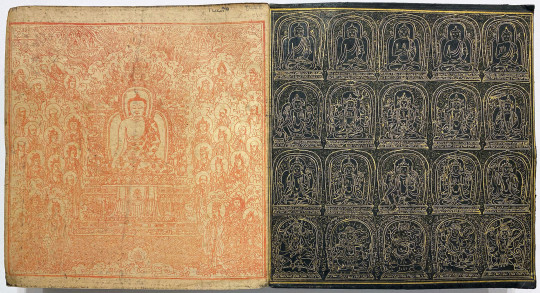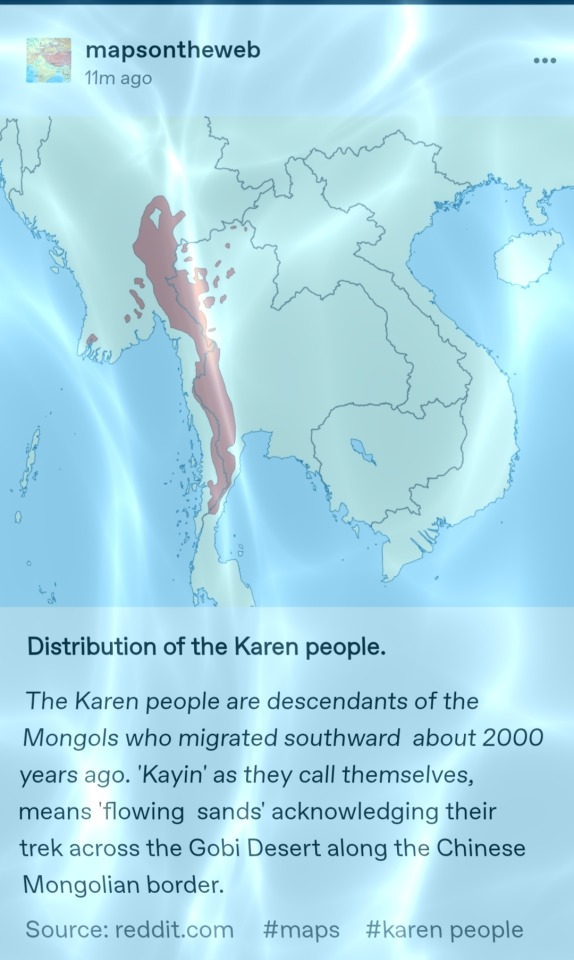#Sino-Tibetan
Text
#polls#linguistics#languages#Slavic#Afro-Asiatic#ytilaremehpe-sselhtaed#Germanic#Indo-Iranian#Baltic#Romance#Uralic#Sino-Tibetan
2K notes
·
View notes
Photo






A Sino-Tibetan concertina-folded book, printed in Beijing in 1410, containing Sanskrit dhāranīs and illustrations of protective mantra-diagrams and deities, woodblock-printed in bright red ink on heavy white paper.
The script is Ranjana/Lantsha, an ornamental form of post-Gupta Brahmi. The text is printed twice, once on each side of the paper, so that the book may be read in the Indo-Tibetan manner by turning the pages from right to left or in Chinese style by turning from left to right.
This folding-book is protected at front and back by thicker board-like wrappers, with both the outside surface and the inside paste-down of each covered in fine pen-drawings in gold paint on black of 20 icons of the Tathāgatas, etc., arranged in 4 rows of 5 figures.
77 notes
·
View notes
Text

PURBA. c. 15th century, Sino-Tibetan. Made of metal alloys, gold, and silver.
A purba is a dagger-like stake with three blades that helps tantric practitioners overcome their aversions to substances that are typically considered abhorrent, like pus and blood. Pierced with the purba, the unsavory substances are ritually transformed into wondrous substances, such as nectar. The Cleveland Museum of Art.
15 notes
·
View notes
Text
LA DIOSA ES LA SEXY CONEJITA EN LA SILLA GIRATORIA
Blowjob hypnosis by Worlds Fastest Hypnotist
RETARD SISTER lends her pussy to BROTHER
Cute ladyboy gets sucked
Busty Shyla Stylez and Alexis Amore Enjoy Sex
Straight stud Mikah Lake gives twink rimjob and bareback anal
Indian Village Girl First Time Forced Sex with Boy Friend Porn Video
Brooke Bliss blows Cullen good at the Cutie Pad
Mais uma de leve
New Mylfs - Big Titted Amateur Milf Jasmine Daze Gets A Warm Creamy Welcome On Her First Porn Shoot
#stamin-#earthquaked#vilayets#sorato#intolerating#unartistically#lentissimo#ambash#Cudahy#Ader#journalise#bataleur#Drina#poikilie#discriminatively#Sino-Tibetan#rocklings#top-castle#gumshoing#leptospiras
0 notes
Photo

Map of the distribution of the Sino-Tibetan Languages
182 notes
·
View notes
Text

Bai girl.
Source: https://pinterest.com/pin/979321881450942146/
2 notes
·
View notes
Text
Someone better at reading both traditional Mandarin script & Japanese Kanji tell me how garbage these names are please, I need to know where I fucked up & I mean that sincerely:
Wo-Chien: Kobashira (蠱柱「こばしら」) Cursed Tower/Poison of (cremation) Ashes/Accursed Deity/Column of Miasma/Cursed Remains or Spirits
Chien-Pao: Seppen (雪片「せっぺん」) Snowflake/Snow Pea/Blade or Edge of Snow/Perfectly Defiled
Ting-Lu: Teitō (釘頭「ていとう」) Nail Head/Staring Head/(to)Pierce (one's) Head(with a nail)/Metal Leader(something or someone in front OR person in authority)/(to)Die (of a) Headache
Chi-Yu: Mikogane (御金「みこがね」) Heavenly or Godly Tribute/Authority of Gold or (trade value) "currency"/Driven Away (by) Stunning Beauty/Imperial Control (of) Wealth/Golden and Godlike (Tyrannical*) Ruler
I had a lot of fun coming up with these & looking at the etymology behind a lot of characters (Proto-Sino-Tibetan glyphs are SO COOL AHHHHHH???) so even hearing "wtf these are such a stretch & sound stupid you weirdo won't be a waste of time for me, I swear.
#pkmn#linguistics#language#mandarin chinese#japanese kanji#on'yomi#hiragana#ruinous treasure quartet#sv spoilers#archaic japanese#proto sino tibetan#PST#special interest#kodoku#i was just re reading up on this & gu ritual magic & on hitobashira while coming up with a nickname for my wo chien in violet#incidentally i named chien pao seppen (snowflake also a partial pun on snow pea)#my ting lu is named teitō (a double play on words with alternate readings of kanji; basically means nail head + head but more layers)#*i actually misremembered this & the two kanji as a compound mean nailhead actually!#i remembered the breakdown backwards lol#anyways finally chi yu is made up of the kanji for royalty/nobility (o-) which can be read in kan'on pronunciation as 'gyo'!#gyo = fish in compounds like 金魚(kingyo/goldfish) or 人魚(ningyo/mermaid)#+ the (archaic?) kanji for gold/money/currency#:3c i hope even if it's clumsy it at least is a little entertaining for someone else 🤟🥰
2 notes
·
View notes
Text
Discover the Mina Language: Insights into Culture, Learning, and Preservation
Unlocking the Secrets of the Mina Language: A Journey into Cultural Immersion
In the vast tapestry of languages spoken across the globe, the Mina language stands as a unique and intriguing testament to the rich diversity of human culture. This article delves into the captivating world of the Mina language, offering an informative and engaging exploration of the people who speak it, their daily…

View On WordPress
#Cultural Heritage#cultural preservation#Language apps#language challenges#Language Learning#LanguageXS#Linguistic Diversity#Mina language#Myanmar#Sino-Tibetan languages
0 notes
Text
resisiting the urge to share a brushing my teeth mirror selfie on my instagram story. i have never felt this insane
#patently untrue i feel insane often#however. not posting pictures of myself on my instagram story insane.#i just realized i need to figure out how to make friends#11pm at a fun anime convention im was here to have fun#what did i do? sit alone on the stairs for an hour reading the (franklu quite juicy) debate about sino-tibetan vs trans-himalayan#by LaPolla and Van Driem. academic articles. Yeah.#then i went backstage to clean. im not even on shift 😭😭😭#this is what i mean by i need to make friends. who arent either 1. other volunteers who outside their shifts have friends#2. friends who leave early to get back home for the night (no shade if u see this but :( )#then i went to go sleep and we get to the mirror teeth brushing selfie. its a good one. my pajamas is cute.#then i went to go sleep and thats how we get to the mirror teeth brushing selfie. its a good one. my pajamas are rly cute rn <3
0 notes
Text
Submitted by @ytilaremehpe-sselhtaed

2K notes
·
View notes
Text
Proto-World update
I haven't visited my Tumblr in quite a while and I'd like to update you people on what I've thought of about Proto-World. I have further proof; Proto-Sino-Tibetan *p/ba, Proto-Turkic *apa, and Proto-Afroasiatic *ʔabw- all seem to descend from the same nursery of [aba] ~ [ʔapa].
0 notes
Note
[rain] i will admit i have no idea what sino tibetan is (there's a language between chinese and tibetan?). i'm a language fan not a language expert. give this anon a break (also ik very little of western african languages since weren't most of them replaced by french? and france actually zaps over most of its colonisation era in favour of the mainland) YES SANSKRIT LANGUAGES ARE GREAT
not replaced by french per se but combined with them
there were syncretized languages (parts of french and the original language)
and then creole languages (original languages affected by french enough to make them vaguely understandable to french people
and pidgin languages (simplified versions of french with limited influence from the original language)
west africa has literally like a hundred languages but the lingua franca there for trade is mainly yoruba
main families are nilo saharan (self explanatory) and niger congo (basically sub saharan)
one of the more well known creole languages over there is sango (ngbandi based) and like most creoles the informal speech is almost entirely ngbandi but the formal speech has more of french loanwords and whatnot
#sino tibetan is just another family like indo european except east asian branches#yes ik sango was used long before colonialization but its the most famous example of african creole I could think of rn#kind of depressing how many creole languages are used today in africa#BUT niger congo grammar does make sense#JUST LIKE SANSKRIT OMG A FELLOW SANSKRIT APPRECIATOR
0 notes
Text
To come to a dialectical conclusion on the clasicide of landlords under Mao Zedong, we must first: (a) understand historical context, (b) understand the popular will during that particular historical moment, (c) understand the material outcomes of the policy, and most importantly, (d) understand the dialectical and materialist foundation, justification, and theory.
Let us fisrt establish the historical context. Classicide ocurred in the late days of the second world war and the infancy of the Peoples Republic. In a roughly 5-7 year span. Predating the communist victory was a 12 year war against Japan, 10+ year civil war (with a break in the middle for the second sino-japanwse war), brief and chaotic rule under the GMD and warlords, followed by the Qing dynasty and beyond. During this time period, the peasantry was the largest and most oppressed class in the country, with minorities such as the Yi and Hui (and most famously, the Tibetan serfs) were entirely enslaved. During thr 1930s, in Shanghai alone, there would be employed body collectors who collected up to 100 dead peasants who had starved or froze to death in the streets. In the rural countryside, landlords held absolute sway over peasants who had to work the land and pay the rent with large proportions of their harvest. Landlords killing peasants for failure to meet quotas or rents was common and unpumished. Landlords raping peasants for rent or not likewise was common and unpunished. Evictions, property seizures, and forfeitures were also exceedingky common and backed by the state. For all intents and purposes, the peasant class was seen as entirely disposable banks of labor and nothing else. The forced selling of children to landlords so a family may survive was also common. The material effect of this millenia old system of oppression is a class full of revolutionary potential and (righteous) justified anger. Fanshen by William Hinton is a good documentary summary of the before and after of a rural peasantry village.
With the communist victory, the CPC put forth a very simple model for reform: assemble a committee of local and communist leaders, take suggestions and proposals from the population which are then put forth to a vote from the population. In many of the northern provinces, where communist bases and reform was more developed than the southern provinces, this process was largely peaceful and orderly. However, in the breadbasket of China, the southern provinces, where landlord control and excesses had been most fierce, the process was not nearly as peaceful. Apprehended landlords, mostly those who continued to try and hold land despite the incoming victory of the communists, were handed to the peasantey based on popular vote and they determined what happened to them. Usually, execution.
The outcome of the purging of the landlords was an egalitarian redistribution of of former landlord holdings to the peasants who actually lived and worked on the land. China at the time had about 500 million people. The landlord class was less than ten percent of the population, holding 70% of all the land. By the end of the land reform campaign, the entire class of landless peasantry was effectively eliminated as landless peasants were now landed.
The materialist and dialectical analysis of the land reform movement is as follows. The landlord class and the peasant class have diametrically opposed interests. The landlords want to maintain as much land as possible while the peasants want as much of the land as possible. There is no compromise solution because inevitably, these diametrically opposed forces will into play and class conflict will begin. If we give each class a 50/50 split, first of all, there would be no peasants to work the landlord's land and in effect, would eliminate the landlord class entirely as this too is a contradiction, but beyond that, the landlords want to get as much land as possible so they will put pressure on the landed peasants to sell or default so they can take it. This is an example of class warfare. Because there exists these antagonistic contradictions, the state exists to mediate class conflict. Before the communist victory, the state was controlled by the bourgeoisie, which included the landlord. This gave them all the power for mediation, allowing them to do whatever they want with no repurcussion, while any protest from peasants are shut down for "violence against property". When the communists put the peasantry in charge of the state, the script was flipped now it was the landlords' turn to eat their own medicine.
Eliminating the bourgeoisie as a class is not a secret communists are trying to hide. It is central to our thesis. By driving out landlords either through reeducation, exile, or killing, the result is rhe same: the destruction of the owning class. The only benefit of the landlord killings (if you want to call it that) is permanently compromising that individual landlord's chance of trying to gain back their power through insurrection, revolt, or other means.
Did excesses happen? Yes. Is killing landlords not ideal? Also, yes. However, we see that the landlord class interest of maintaining as much land as possible comes into conflict. The landlords were willing to rape, murder, enslave, evict, etc. to get more land before communist rule, and they were willing to kill and maim to keep it (hence why there was a civil war!). The contradiction thus could only be solved via violence. Thus, to criticize the landlord class liquidation is equivalent to criticizing the Algerians, or Vietnamese, or African slaves in Haiti and the americas in general as terrorists for fighting back, an opinion which only makes sense if you are not a member of these oppressed groups and classes.
You are, more likely than not, living in a dictatorship of the bourgeoisie. You are, more likely than not, not a member of the bourgeoisie (you work for a wage or salary and don't own things like a company, land, machibery, etc.), but rather a member of the proletariat. However, the ruling class in your country is not your class; it is the bourgeoisie. Therefore, the state has a vested interest in maintaining bouegeoisie rule. To that end, the media, economists, historians, teachers, etc. are groomed and incentivized into upholding bourgeoisie ideology. Thus, the rising of peasants against the bourgeoisie is seen as abhorrent violence, but the mundane violence of eviction, homelessness, starvation, as well as the casual murder, rape, and enslavement of the peasantey is simply seen as the cost of business at best, or entirely ignored or seen as good at worst. Thus, much of the literature on proletariat action is full of lies, exageration, and a focus on the bourgeoisie rather than the average person; the media has a bourgeoise class nature.
Know your class. Know your comrades. Know your class enemies.
340 notes
·
View notes
Text
these are all off the top of my head, so i apologize if a listed language is technically part of another language family/branch!
also, i wish i had more than ten options, but alas (so if you speak a language that isn’t in any of these families/branches please tell me, i’m really curious!!)
497 notes
·
View notes
Text

Not reblogging but basically all of this is unjustified, undecided, or simply untrue. The Karen aren't even from one place, they're multiethnic and by most trustworthy sources I've found probably from Tibet and China. Even the Karen Organization of Minnesota takes a more skeptical position:

And "Kayin" does not have a decided etymology at all:


They don't even speak Mongolic-related languages. The Karen all speak Tibeto-Burman languages which further entrench them as being Sino-Tibetan:

150 notes
·
View notes
Text

Dungan bride, Kazakhstan.
Source: https://pinterest.com/pin/1144336586560747614/
2 notes
·
View notes